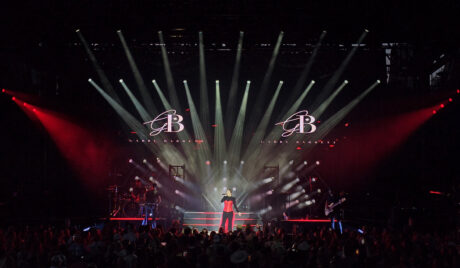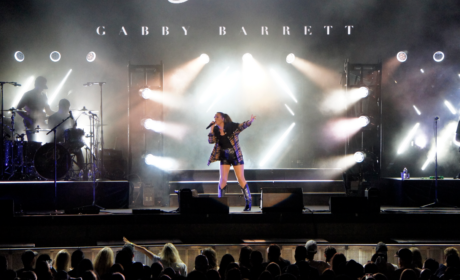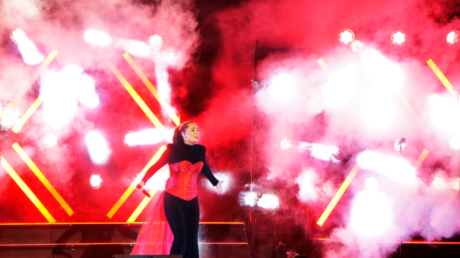
Gabby Barrett had two simple words of advice for Erik McCandless when he set out to design the show for her 45-city 2023 North American tour: think big! The rising, young multi-platinum country star wasn’t thinking about the size of her rig, or its punching power. She was more interested in how expansive it could be in terms of incorporating different looks. That made her an ideal client as far as this LD was concerned.
 “Gabby is constantly looking for new territory with staging and trying to introduce new elements to elevate the show,” said McCandless. “As a designer, that’s the best thing you could ask for. Gabby has reached the top of the country charts, but her influences were not limited to that genre. Having been raised on a lot of pop and rock’n’roll as well as country, she wanted us to look to artists like Michael Jackson and Prince for inspiration, as these were important to her in her youth.”
“Gabby is constantly looking for new territory with staging and trying to introduce new elements to elevate the show,” said McCandless. “As a designer, that’s the best thing you could ask for. Gabby has reached the top of the country charts, but her influences were not limited to that genre. Having been raised on a lot of pop and rock’n’roll as well as country, she wanted us to look to artists like Michael Jackson and Prince for inspiration, as these were important to her in her youth.”
McCandless took this feedback and ran with it, creating a muti-dimensional rig that opens the way to a diverse range of looks, from the soft and subtle to the bright and intense He achieved this vision by pixel mapping his entire rig, which was supplied by Production Technology Partners (PTP) of Nashville, and featured Rogue Outcast 1 BeamWash, as well as COLORado PXL Bar 16 fixtures from CHAUVET Professional.
“I pixel mapped to create a graphic surface behind Gabby and the band that had enough versatility to give every song a new environment, while also bringing enough volume to fill any dead space onstage,” he explained. “We had three pre-existing risers that we wanted to keep using from our 2022 tour. This created a fairly long footprint. Since most of this year’s dates were support slots in amphitheaters, I needed something that could transform three risers into a cohesive set, move on and off stage quickly, and in some cases, compete with the sun.”
To accomplish this, McCandless decided to arrange his fixtures on three video carts that he could arrange to create a graphic array of lines and circles that worked for large rig-wide sweeps and wipes. He then created separate pixel maps of every fixture’s elements so he could build clean transitions and effects in any layer quickly.
 For the 32 Rogue Outcast 1 BeamWash fixtures in his rig, the pixel mapped the main mover body and LED ring. “Each song utilized a different combination of fixture layers to create its own little world,” said McCandless. “For example, with Gabby’s cover of ‘Need You Now,’ I put us in a neon world of color bars and had the Outcast’s rings set in multiple vibrant shades of blue, green, and pink.”
For the 32 Rogue Outcast 1 BeamWash fixtures in his rig, the pixel mapped the main mover body and LED ring. “Each song utilized a different combination of fixture layers to create its own little world,” said McCandless. “For example, with Gabby’s cover of ‘Need You Now,’ I put us in a neon world of color bars and had the Outcast’s rings set in multiple vibrant shades of blue, green, and pink.”
Pixel mapping the entire rig was not without its challenges, according to McCandless. “I ended up not using as many bitmaps as I thought I would,” he said. “They didn’t translate super well across five different fixture control surfaces. Certain colors that wouldn’t match, fixture brightness had to be constantly evened out. So, instead, I found myself using the pixel maps to create pages of selection orders groups and macros that could ‘copy’ looks and create delays across the whole rig from the first unit. This not only sped up programming, but it kept any wipe effects cleaner than if I were to select from a layout view.”
The end result of this pixel mapping was well worth the effort. Working with lighting director Vanessa Sexton and production-tour manager, Tayler Bock, McCandless created a show that was filled with engaging, memorable looks. This was beautifully evident when Barrett sang her hit “Never Get It Back.” McCandless used an effect on the Outcast rings to simulate ticking clocks throughout the entire song. As the song built, the entire stage became. a sea of ticking clocks, their hands made from moving light beams and LED surfaces. “This ticking effect is a trick I started calling ‘speed bumps,’ where I have the same effect on two different executors, one at minimum speed and one at a high speed,” said McCandless. “The low-speed stays on, while the high speed gets bumped to the song beat, resulting in what looks like an effect starting and stopping, picking up where it left off in the way that a clock-hand ticks.
 “Throughout our show, the ring element of the Outcasts was essential to the look of our rig,” continued McCandless. “I could create a song’s world just by turning a layer of any fixture on or off, but the go-to starting point for me was matching the Outcast rings to the bar lines. It gave the rig a neon effect that tied the entire design together.”
“Throughout our show, the ring element of the Outcasts was essential to the look of our rig,” continued McCandless. “I could create a song’s world just by turning a layer of any fixture on or off, but the go-to starting point for me was matching the Outcast rings to the bar lines. It gave the rig a neon effect that tied the entire design together.”
The Rogue Outcast 1 BeamWashes along the COLORado PXL Bar 16 fixtures were also critically important in helping McCandless keep light focused on his client. “One of my biggest pet peeves as a designer is seeing a ton of lights onstage, but only seeing a flat front spotlight on the performer,” he said. “Even worse is when every light onstage is on and you can’t find the artist.
“Our rig for this tour had a lot of lit surfaces to look at, and all of it was more or less pointed at the audience’s eyes,” continued McCandless. “Using the Outcasts combined with overheads and the PXL bars, I could carve Gabby out of even the brightest and flashiest of sequences. She tends to cover the entire stage, so a trick I’ve used is to create temp faders that point movers at each corner of the stage, and one for center. I could set these fixtures in the song to be on her mic stand, then have the temp faders available in combination to manually follow her as she moved about the stage.”
Given her persona and engaging personality, Gabby Barrett creates a dynamic stage presence. On this tour she stood out with even more dynamism thanks to a lighting design that reflected all of the “big vision” she puts into her music.
Further information from CHAUVET Professional: www.chauvetprofessional.com


